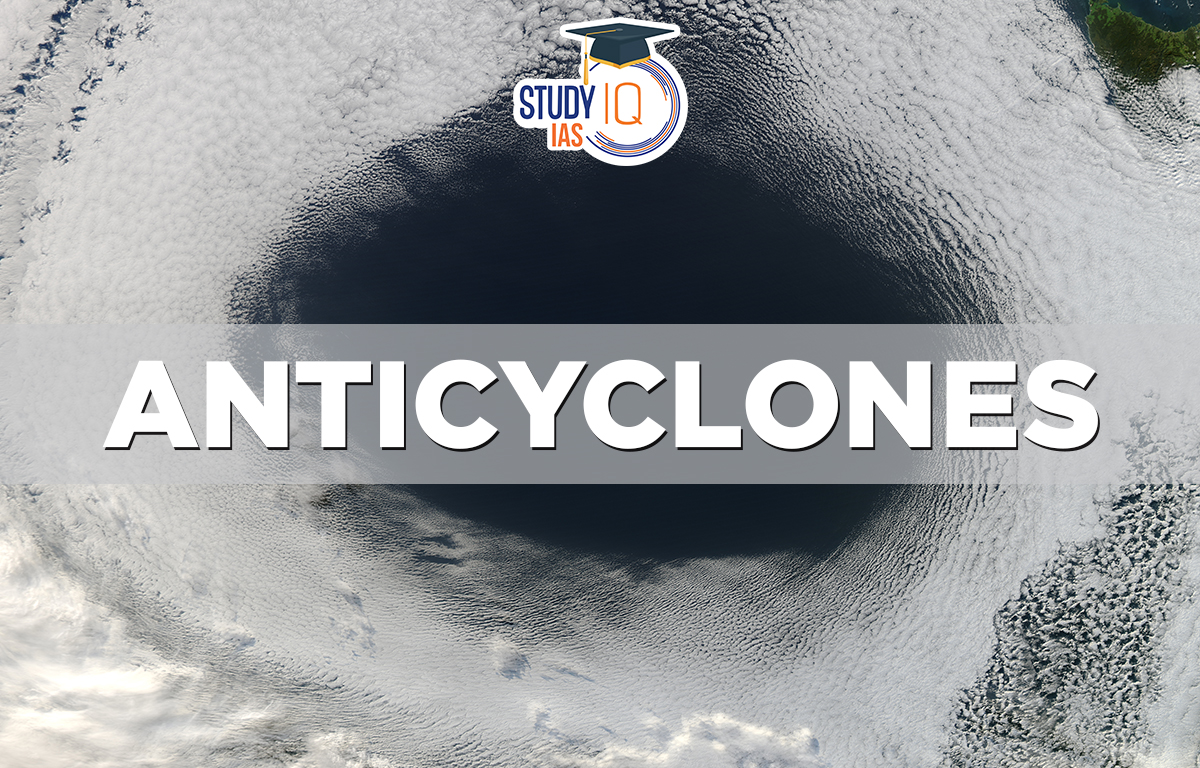Table of Contents
Anticyclones
Areas where the air is sinking, creating high pressure, are called anticyclones. They are the opposite of cyclones. High-pressure systems have gentle winds because the air pressure does not change quickly. As the air sinks, it warms up, leading to dry and warm weather. Anticyclones are much larger than depressions and can bring calm weather that lasts for days or even weeks. They block storms, slowing them down or pushing them around the high-pressure area, which are known as “Blocking Highs.”
As air descends, the pressure increases. When the air reaches the ground, it has to move somewhere. The Earth’s rotation causes the air to change direction: in the Northern Hemisphere, it moves clockwise, and in the Southern Hemisphere, it moves counter-clockwise. This can be seen in diagrams of anticyclones. This article will explain Anticyclones, which will help you prepare for the UPSC Civil Service Exam in Geography.
Read More: Tropical Cyclone
Anticyclones Concept
Anticyclones are pressure centres. They are surrounded by closed isobars with decreasing pressure outward. Air blows outward in a clockwise direction in the Northern hemisphere and an anticlockwise direction in the Southern hemisphere due to the circulation from a central area of high pressure to the periphery. Blowing winds are deflected from their paths to the right in the Northern hemisphere and left in the Southern hemisphere due to Coriolis Force, which is how a flowing system becomes circular.
The pressure difference between the centre and periphery of an anticyclone is typically 10 to 20 mb, but can be higher. Because the diameter is 75% larger than that of Temperate Cyclones, they are much larger in size and area.
Temperate anticyclones are very large and can cover nearly half of the United States. They can change direction a lot and may stay in one place for up to four days. They usually move slowly, at an average speed of 30 to 50 km/h. Anticyclones form when either cold polar air or warm tropical air sinks. These anticyclones are high-pressure systems found mostly in subtropical and polar regions where air sinks from the upper atmosphere to the lower atmosphere. They are almost never found in equatorial areas.
Read More: Water Cycle
Anticyclones Formation
As a cyclone moves away, an active anticyclone forms over a ground site in the cold air zone behind it. An anticyclone forms before the next cyclone enters the area. These are also known as cold anticyclones. In contrast, the downward air velocity in an anticyclone compresses the descending air.
As a result of the compression, the air warms. As a result, the air forming the anticyclone at altitudes of 2 to 5 km (1 to 3 miles) above the ground warms over time, and the anticyclone eventually becomes a warm anticyclone. They can last a week or more, and a small number of these blocking anticyclones can completely alter the course of a season. Sun-blocking anticyclones are particularly common over Europe, the eastern Atlantic, and the Alaskan region.
Read More: Climate of India
Anticyclones Characteristics
Characteristics of Summer Anticyclones:
In summer, anticyclones bring few or no clouds, resulting in strong sunshine and hot weather. The winds are light, and as the ground cools at night, morning mist can form. Warm, moist air rising from the ground can lead to thunderstorms.
Characteristics of Winter Anticyclones:
In winter, anticyclones lead to clear, cloudless skies. The temperatures drop, making days cold and nights even colder because there’s no cloud cover. Fog and frost often form at night.
Read More: Evaporation and Condensation
Anticyclone Types
1. Cold Anticyclones
These cyclones, called thermal anticyclones, form above the Polar Regions when air sinks. After the polar air sinks, it moves toward the east and southeast.
2. Warm Anticyclones
These are called dynamic anticyclones and form above warm subtropical regions when air sinks from the upper part of the atmosphere to the lower part. This causes the air to spread out.
3. Blocking Anticyclones
These anticyclones form when something blocks the air circulation in the upper atmosphere over mid-latitudes. They are called “blocking” because they stop the movement of temperate cyclones in these areas. Anticyclones usually bring steady weather. As air descends from above, it creates clear and dry conditions due to the stability from the sinking wind. Anticyclones are common in Canada, the United States, and northern Eurasia.
Read More: Humidity
Anticyclones Significance
- When combined with blocking highs, anticyclones cause periods of little or no rain that can last for days or weeks.
- They aid in the recharge of aquifers.
- Anticyclones aid in the regulation of ocean temperatures.
- By increasing the flow of rivers and streams that carry garbage, anticyclones pull nutrients into the sea.
Read More: Fronts
Difference between AntiCyclones & Cyclones
| Cyclones | Anticyclones |
| They have low pressure at the centre, surrounded by high pressure on all sides. | They have high pressure at the centre, surrounded by low pressure on all sides. |
| Winds blow towards the centre. | Winds radiate out from the centre. |
| Winds are violent and destructive. | Winds are mild and not destructive. |
| Winds blow in anti-clockwise in the northern hemisphere and clockwise in the southern hemisphere. | Winds blow in a clockwise direction in the northern hemisphere and anti-clockwise in the southern hemisphere. |
| They present cloudy weather accompanied by thunder, lightning and heavy rain. | They present calm and clear weather. |
Read More: Precipitation
Anticyclones UPSC
Although anticyclones are not as well studied as cyclones, they are important because the clear and dry conditions associated with them can allow for strong nighttime radiative cooling and cold surface temperatures. Pollutants may accumulate near the Earth’s surface due to the convectively stable air of anticyclones. Finally, the anticyclones’ blocking action above the Earth’s surface may result in consistently abnormal weather conditions.


 Desert Climate, Distribution, Climatic C...
Desert Climate, Distribution, Climatic C...
 Deserts of India Map, Features of Thar D...
Deserts of India Map, Features of Thar D...
 Indus Valley Civilization, History, Phas...
Indus Valley Civilization, History, Phas...





















